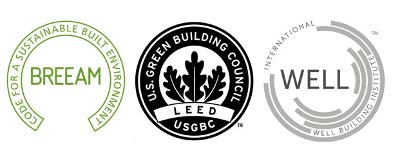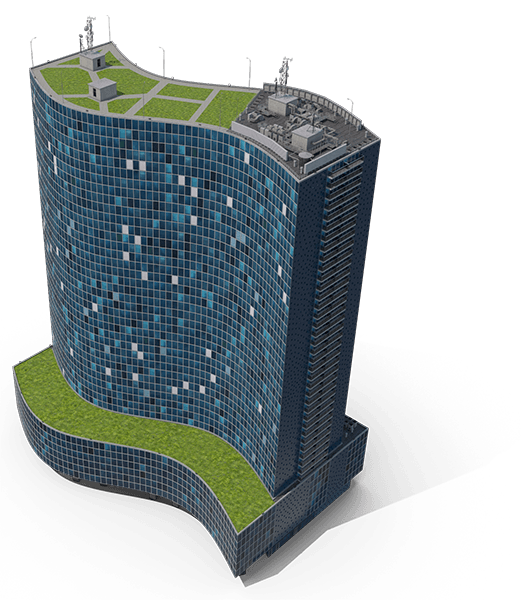
Today we are going to talk about three certifications that are references in sustainability and well-being for buildings: BREEAM, LEED and WELL. Do you know what they mean and what their advantages are?
If you’re interested in building or renovating a building in a sustainable way, you’ve probably heard of certifications like BREEAM, LEED and WELL. But what do they mean and what are their differences and benefits? In this article, we’ll explain what these certifications are, how they work and how they can help you create a healthier, more efficient and responsible environment.
BREEAM, LEED and WELL are sustainability assessment and certification systems for buildings, which measure their performance in different environmental, social and economic aspects. Each system has its own methodology, criteria and requirement levels, but they all share the goal of promoting sustainable construction and recognising good practices in the sector.
BREEAM (Building Research Establishment Environmental Assessment Method) is an environmental assessment method created in the UK in 1990, which measures the performance of buildings in several categories such as management, health, energy, water, materials, waste, transport, land use, ecology and pollution. The aim is to reduce the environmental impact of buildings and improve the quality of life of occupants. Buildings that meet the BREEAM criteria receive a rating ranging from Pass to Outstanding, according to the score obtained.
LEED (Leadership in Energy and Environmental Design) is a certification system created in the United States in 1998, which recognises best practices in the design, construction and operation of sustainable buildings. LEED evaluates buildings in six categories: location and transportation, sustainable space, water efficiency, energy and atmosphere, materials and resources, and indoor environmental quality. In addition, there are credits for innovation and regional priority. Buildings that meet LEED requirements receive a rating ranging from Certified to Platinum, according to the score obtained.
WELL (WELL Building Standard) is a certification system created in the United States in 2014, which focuses on the health and well-being of building occupants. WELL evaluates buildings on seven concepts: air, water, nutrition, light, exercise, comfort and mind. The aim is to create environments that promote quality of life, productivity and user happiness. Buildings that meet the WELL criteria receive a rating ranging from Silver to Platinum, according to the score obtained.

The three certifications have in common the fact that they are internationally recognised and contribute to sustainable development of buildings. In addition, they bring benefits to building owners, investors, managers, designers and users, such as:
- Improve the functionality, flexibility and durability of buildings;
- Optimising building performance;
- Reducing environmental impact;
- Potential reduction in energy, water and waste consumption;
- Reduce operating and maintenance costs;
- Increase the satisfaction of the users of the building;
- Increase the value of property;
- Decrease work absenteeism when buildings are workplaces.
The three certifications can also be combined with each other to optimise building performance for the benefit of the environment and the health of the occupants. For example, a building can be certified by BREEAM or LEED in relation to its sustainability and by WELL in relation to its well-being.
Obtaining a BREEAM, LEED or WELL certification can bring many advantages to owners, managers, designers and users of certified buildings. Some of these advantages are:
- Improve the functionality, flexibility and durability of buildings;
- Optimising the energy, water and environmental performance of buildings;
- Reduce the environmental impact of buildings in terms of greenhouse gas emissions, waste generation and air pollution;
- To reduce the operating and maintenance costs of buildings;
- Increase building occupant satisfaction, productivity and health;
- Increase the market value of properties;
- Differentiate from the competition and demonstrate commitment to sustainability.

Each of these systems has its own methodology, criteria and certification levels. However, they all follow a similar process involving the following steps:
- Preliminary assessment: before starting the certification process, it is recommended to make a preliminary analysis of the building to check its current conditions and the possibilities for improvement in relation to the requirements of the chosen system. This assessment can be done by a specialised consultant or by the system itself through an online tool.
- Registration of the project: after deciding for certification, it is necessary to register the project on the online platform of the chosen system, paying a corresponding fee. This registration ensures access to the technical documents and guidance required for the certification process.
- Gathering of evidence: in this stage, it is necessary to gather the evidence that demonstrates that the building complies with the criteria required by the system. This evidence can be documents, photos, reports, tests or measurements that prove the sustainable characteristics of the building.
- Submission and review: after collecting the evidence, it must be sent to the certifying body of the chosen system, which will check if it is valid and sufficient to achieve the score required for certification. This revision can be done by an external auditor or by the system itself through an online tool.
- Obtaining the certificate: if the building passes the review successfully, it will receive a certificate attesting to its level of sustainability according to the chosen system. This certificate has a validity determined by the system and can be renewed upon new evidence.

WiseBuilding® can provide technical support for any project that enables you to start a certification process. Contact us.
WISEFRAMEWORK is a BACnet B-AWS certified software solution for state-of-the-art integration, control, management and visualisation in building automation systems. Designed to redefine the way buildings are operated through an open platform and seamless harmonisation between building-generated data by supporting multiple protocols including BACnet, Modbus, KNX, OPC-UA and MQTT. Through the use of Haystack technology, the software also empowers the building for the future at the forefront in the integration of the various technical systems.


